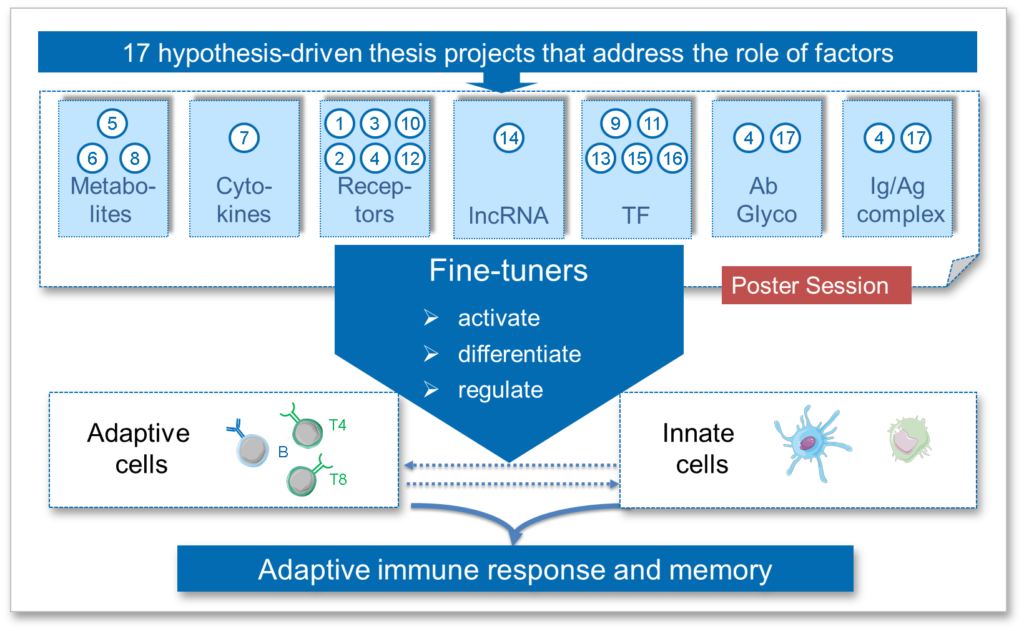Projects
Projects of the 1. cohort
| P1 | Diana Dudziak Dissemination of TLR-activated DC subsets determines early and late T cell stimulation events and the outcome of protective immune responses |
| P2 | Dirk Mielenz EFhd2 links cytoskeletal dynamics and metabolism in B cells |
| P3 | Alexander Steinkasserer Role of aryl hydrocarbon receptor for the induction of tolerogenic dendritic cells |
| P4 | Anja Lux The role of DCIR1 in adaptive immunity |
| P5 | Gerhard Krönke Dissecting the functional diversity of macrophage subsets in inflammation and resolution during rheumatoid arthritis |
| P7 | Roland Lang Tuning of adaptive immune responses by TNFα at the level of C-type lectin receptor expression |
| P8 | Dimitrios Mougiakakos Glycolytic flux as a checkpoint of human Th1 differentiation |
| P9 | David Vöhringer Role of CD8 T cells in atopic dermatitis |
| P10 | Udo Gaipl Role of HVEM in radiation-induced anti-tumor immune responses |
| P11 | Kai Hildner Analysis of the cell-intrinsic role of Batf as a transcriptional checkpoint of intestinal tissue-resident (TRM) T cell differentiation |
| P12 | Lars Nitschke The role of Siglec-10 and DNAse1 mutations in systemic lupus erythematosus (SLE) |
| P13 | Thomas Winkler Signaling circuits involved in the selection of high-affinity antigen-specific B cells in the germinal center |
| P14 | Hans-Martin Jäck The role of B cell Maturation Antigen (BCMA) in long-lived plasma cell survival |
| P15 | Aline Bozec The role of VHL in B cell responses and rheumatoid arthritis |
| P16 | Stefan Wirtz The role of the transcription factor interferon-regulated factor 1 (IRF-1) for B cell homeostasis |
| P17 | Ulrike Steffen Characterization of plasma cell subsets with different cell surface sialylation |
Projects of the 2. cohort
| P2 | Dirk Mielenz
The effect of mitochondrial Ca2+ abundance on mitochondrial function and morphology in B cells |
| P3 | Andreas Wild / Alexander Steinkasserer
Soluble CD83-induced pro-resolving macrophages accelerate the wound-healing processes in hard-to-heal wounds |
| P4 | Anja Lux
Modulation of IgG effector functions by the interplay of DCIR and FcϒRs on dendritic cells |
| P7 | Roland Lang
Regulation of adaptive immunity by myeloid cell-derived itaconate |
| P9 | David Vöhringer
Fine-tuning of germinal center response by STAT6-regulated genes |
| P10 | Udo Gaipl
RIG-I pathway as a key regulator for radiotherapy-induced anti-HNSCC T cell responses |
| P11 | Kai Hildner
Role of transcripiton factor Id2-dependent regulation of tissue-resident memory (TRM) T-cells in colorectal cancer |
| P12 | Lars Nitschke
The role of di-sialic acids and O-acetylated sialic acids in plasma cell differentation |
| P14 | Katharina Pracht / Hans-Martin Jäck (retired since 10/2024)
Role of the N-glycanase 1 (NGLY1) in the formation and function of antibody-secreting cells |
| P15 | Aline Bozec
Define the effect of L-arginine supplementation on B cell differentiation and humoral response |
| P16 | Stefan Wirtz
The biological function of IRF1 for intestinal immune-epithelial communication |
| P17 | Ulrike Steffen
The role of IgA and IgG as effector molecules in adaptive immune responses |
| P18 | Wolfgang Schuh
The function of Glutaminyl-peptide Cyclotransferase Like Protein (QPCTL) in plasma cells |
| P19 | Iryna Prots
Elucidating the fine-tuning mechanisms of T cell activation and differentiation by alpha-Synuclein |
| P20 | Anja Werner
B cell-intrinsic alpha-2,6-sialylation in autoimmunity |
| Mario Zaiss
Microbes fine-tune B cell responses to modulate chronic pain |

